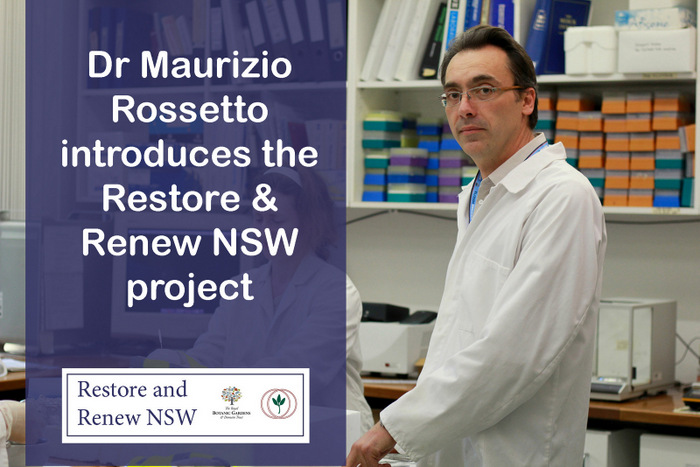
An important consideration in any restoration project is where to source seed and other plant material to be planted on selected sites. Similarly, evaluating how to store and germinate seed can have a profound impact on long-term success. Despite the importance of these decisions, obtaining the necessary information can be challenging. Restore and Renew NSW responds to this challenge.
Click on the above image to view a video of Dr Maurizio Rossetto, Principal Research Scientist with the Royal Botanic Gardens and Domain Trust, outlining the vision for the Restore and Renew NSW project.
Objectives of the Restore and Renew NSW Project
Restore and Renew NSW will develop research-based, detailed and specific restoration guidelines for over 200 plant species which are considered useful in restoration projects across NSW. Genetic, adaptive, environmental, and ecological information will be collected for all 200+ species by taking advantage of innovative research techniques. For example, Next Generation Sequencing, a technique similar to that used in the ‘Human genome project’, will be used to collect genetic information on a scale never before attempted in plants.
The resulting research outcomes and restoration guidelines will be publicly available through a practitioner-friendly website.
While initially providing guidelines for around 200 species, research outcomes will also help to identify predictive generalisations that can be applied across many of the other species used in restoration throughout NSW.
How useful will Restore and Renew NSW be?
To ensure Restore and Renew NSW provides useful outcomes, restoration practitioners were consulted in the early stages of project development.
An online survey targeting anyone involved in native vegetation restoration projects in NSW was conducted in 2013. Survey respondents were provided with a summary of the type of information the Restore and Renew NSW project will provide and asked how useful they thought this information would be.
86.4% of survey respondents claimed the information would be ‘extremely useful’, ‘very useful; or ‘useful’.
Selecting the species to include in Restore and Renew NSW
The online survey of restoration practitioners guided the list of species to include in Restore and Renew NSW.
One of the key objectives of the survey was to identify which species are ‘most commonly used’ in restoration and revegetation projects
across NSW. A total of 730 species were identified as ‘commonly used’ by 147 respondents.
Participants of an expert workshop where the outcomes of the online survey were reviewed. From left to right: Peter Cuneo, Michelle Leishman, Linda Broadhurst, Chris Allen, Maurizio Rossetto, Doug Benson, Andrew Denham, Tony Auld.
Following the online survey, an expert workshop was held in March 2014 to refine the list of species to include in Restore & Renew NSW to the target 200. After a critical review, a final group of 232 species were selected.
The refinement of the list took into account frequency of use as well as the need to capture sufficient geographic, environmental and functional diversity.
Most of the “top 200” taxa listed by survey respondents are included in the final list, suggesting that NSW restoration practitioners are using a geographically and functionally diverse range of taxa in restoration projects.
The final list of 232 species to be included in Restore and Renew NSW can be downloaded here.
Restore and Renew NSW – next steps
The Restore and Renew NSW project is taking the innovative and exciting approach of using citizen scientists to collect plant material from a large number of sites spanning the entire state of NSW. Using citizen science collection teams actively engages the community and increases the feasibility of such extensive sampling. Regional citizen science collection teams will receive training in plant identification and the collection of leaf material for DNA testing.
Priorities over the coming months include finalising the sampling strategy, establishment of citizen science collection teams, and securing corporate and philanthropic support for this project.
A range of sponsorship levels are available for this project, including an opportunity for corporate sponsors to be identified as Founding Partners. Should a sponsor have a planned restoration project, there may be opportunities to include specific species in the project (subject to level of support).
For further information please go to the Restore and Renew NSW website.

